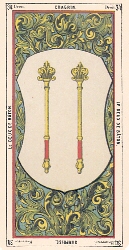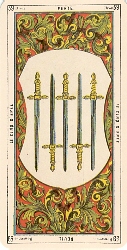An Invitation to Comment on an
Apparent Nineteenth-Century
Russian Etteilla-Style Tarot Deck
By James W. Revak
![]()
An Invitation to Comment on an
Apparent Nineteenth-Century
Russian Etteilla-Style Tarot Deck
By James W. Revak
However, the Russian deck differs significantly from any Etteilla-style deck with which this author is familiar. Specifically, the numeric cards of the Russian deck are fully illustrated, i.e., they show figures and scenes rather than suit-signs (pips) only. Further, the illustrations clearly depict divinatory meanings. By contrast, all numeric cards from all other Etteilla-style decks essentially comprise suit-signs only. For example, compare the Two of Scepters from the Russian deck with the corresponding card from Tarot égyptien (see the pair of cards, below left). Etteilla associated chagrin [sadness] with this card; however, only the Russian one is completely illustrated and depicts the divinatory meaning. By contrast the card from Tarot égyptien depicts two scepters only. Similarly, compare the Five of Swords from the Russian deck with the corresponding card from Tarot égyptien (see the pair of cards, below right). Etteilla associated perte [loss or degradation] with this card; however, only the Russian one is completely illustrated and depicts the divinatory meaning. By contrast the card from Tarot égyptien depicts five swords only.




Illustrations (left to right): Two of Scepters (divinatory meaning = sadness) from the Russian Etteilla-style Tarot (1861), and the corresponding card from Tarot égyptien: grand jeu de l’oracle des dames (first published c. 1870, re-published by Éditions Dusserre); Five of Swords (divinatory meaning = loss or degradation) from the Russian deck; and the corresponding card from Tarot égyptien. Note: The illustration which comprises the Five of Swords from the Russian deck is based on a well-known Hellenistic sculpture commonly called The Dying Gaul. Click the images for larger ones.
ABOUT THE SCANS The author is indebted to Sergey Davydov for kindly making the scans available to him. Unfortunately, they fail to capture the original cards well because they were prepared from a photocopy of the deck. Mr. Davydov neither possess the cards nor does he know their present whereabouts. Despite the mediocre quality of the scans, publication of them is justified by the unique nature of this deck and implications it may hold for Tarot history.
WHY THIS DECK MAY BE IMPORTANT Tarot historians have often asserted that with the notable exception of the fifteenth-century Sola-Busca deck, fully illustrated numeric cards were unknown prior to publication, in 1909, of the Rider-Waite-Smith deck (designed by A.E. Waite and drawn by Pamela Colman Smith). They credit Waite and Smith with the first modern use of fully illustrated numeric cards, and in part for this reason they describe their deck as seminal. Furthermore, Waite, in his The Pictorial Key to the Tarot (1910), asserted that their deck was the first modern Tarot with fully illustrated numeric cards: “In regard to the Minor Arcana, they are the first in modern but not in all times to be accompanied by pictures, in addition to what is called the ‘pips’. . . .” However, if the Russian deck is genuine, the position taken by these historians and Waite are wrong. Instead, one would have to conclude that some modern Tarotists used fully illustrated numeric cards as early as 1861, i.e., forty-eight years prior to publication of Rider-Waite-Smith.
YOUR COMMENTS ARE WELCOME Numerous questions come to mind with regard to the Russian deck. How might one confirm its provenance and date? Is it, or cards from it, extant? With the exceptions of the Sola-Busca and Russian decks, did others with fully illustrated numeric cards exist prior to Rider-Waite-Smith? Do you, the reader, have further information or thoughts concerning the Russian deck? If you have any clues which may lead to answering any of these questions, or shed light on these unusual cards in any way, please e-mail the author by clicking here.
WHAT’S NEW IN THIS VERSION, HOW THIS ARTICLE IS ORGANIZED This article previously appeared in a different form in Villa Revak under the title Do You Know Anything About This Unusual Deck? . The new version, which you are reading, includes a revised introduction, scans of twenty-four new cards (mostly Major Arcana) from the Russian deck, and, for the first time, scans of four cards from Tarot égyptien for comparison purposes. All illustrations in the table of contents, which are new, are labelled as such.
The balance of this article is devoted to images from the Russian deck. In the case of Minor Arcana, they are identified by title, principal divinatory meanings espoused by Etteilla and his followers, and Etteilla’s unique system of numbering. In the case of Major Arcana, they are identified by title, corresponding card in more traditional decks (where appropriate), and Etteilla’s numbering.
OTHER RESOURCES If you want to receive word whenever this article is updated, subscribe to the free Villa Revak Bulletin. Finally, Russian readers will enjoy Andrew Kostenko’s article about this deck, 1861 Russian Etteilla Deck.
(continued, click here)
NEXT PREVIOUS CONTENTS E-MAIL AUTHOR HOME

Copyright © 2002 James W. Revak. All rights reserved. Version 2.0 (1/1/02).